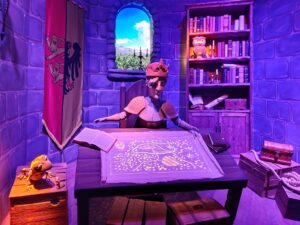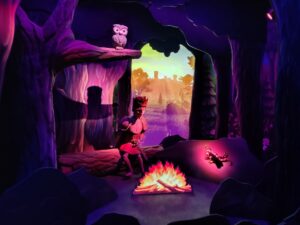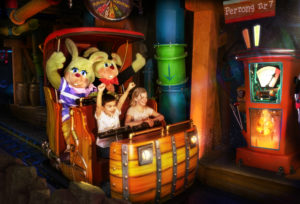
Disney California Adventure premiered a new ride in 2001, Soarin’ over California. It was not just a new attraction for the park, it was a world first; the Flying Theatre was born. It would take nine years before a non-Disney theme park could premiere a similar ride, Feeling Taiwan at E-DA World (Taiwan). The ride was built by Brogent Technologies, Inc. from Kaohsiung, Taiwan. In our previous special about Brogent we spoke with marketing and sales director Stefan Rothaug about the history of the company and created an overview of their ride catalogue. This time, we take a further look into the creation of their most successful ride to date, the Flying Theatre, or i-Ride as Brogent calls the model.
Developing the first Flying Theatre
While developing the new E-DA World, the owners of the future park were inspired by the Soarin’ rides in Disney’s theme parks and wanted one of their own. However, Walt Disney Imagineering co-developed Soarin’ themselves (with Dynamic Attractions) and did not allow their rides to be copied. E-DA World could not get the same ride and therefore turned to Brogent. As described in the previous special, Brogent was merely a software developer in those days and had no experience in building amusement rides. The company would soon find out what it takes to develop such a ride.
“The biggest challenge, I think, was the patent from Disney. That was the only obstacle we had. We had to do something that delivers a similar experience, but does not infringe the patent of Disney”, says Stefan. It required thinking on a different level. Well, on multiple levels, you could say. In Soarin’, all gondolas are placed behind one another during (un)loading and they move up above each other at the start of the ride. One of the major changes that Brogent made was to place the gondolas on different levels of the building. “That was the biggest change, which is now always a big discussion in the flying theatre industry. Some people like it better to enter from one platform and some people like it our way. There are a lot of advantages and disadvantages for each option, but since we decided to go this path in the early days, we now optimized everything to the advantages of this setup.”
Riders are taken to the level where they will be seated. Each level has a balcony with the seats of the gondolas on one side and the movie screen on the other (sometimes there is a curtain between the balcony and the screen). When the ride starts, the railing of the balcony drops and the gondolas move forward over the edge, clearing themselves from the floor. With this concept, the gondolas do not have to move upwards anymore, only forwards.
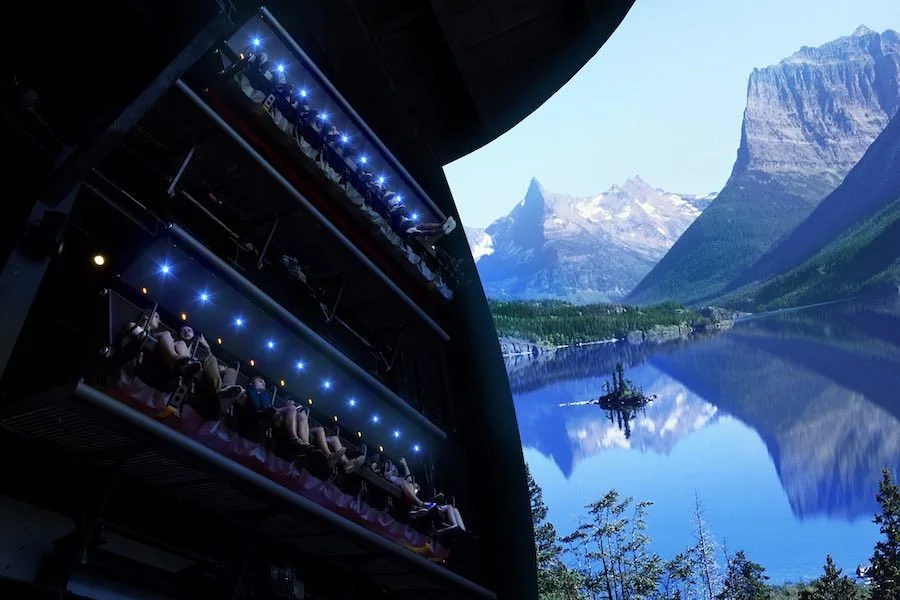
“The biggest advantage is that we can use a modular design. I take This Is Holland in Amsterdam for example: we have four gondolas with each 10 seats. So we got two levels, with 20 people on the first floor and 20 people on the second floor. Two gondolas per level and those gondolas are all fully independent. That means from operational side, if we have a failure in the system and one gondola is not operational, we still can have 30 people on the ride and have it operational”, tells Stefan, “On the other hand as well, if you have a off-peak day you can just operate one floor and you can keep the other one closed and save on operation costs.” This is a huge difference with Soarin’, where there are always three gondolas linked to each other.
An often-heard disadvantage of a multiple level ride is that an operator will need staff members on every floor. However, Stefan disagrees that this is a disadvantage. “If you have a peak day, you will need people on every floor. But if you have a peak day in a theatre like Soarin’, you also need people on each row to get the seatbelts checked quickly. If you want operation excellence, you need those staff anyway. For us it is on the first, second, third floor, for them it would be in the dispatch hall on each row, so in the end I think it’s the same demand for the operation crew.”
In the first design for E-DA World, Brogent placed the gondolas suspended from the ceiling. The motion system was placed between the ceiling and the gondola and consisted of a so-called Stewart Platform. This is a system that can provide the gondola six degrees of freedom, meaning it can move across three axes (up or down, left or right, back or forwards), but also rotate over each axis. The original system of Soarin’ only has three degrees of freedom.
However, there have been a lot of technical developments between the first and latest i-Ride. Stefan explains: “There is always a development. We are still a project based company. We are not mass producing anything. I think we usually do three to five openings a year, but 2021 was a crazy year with more than 20 ride systems opening around the world. That means we have to learn a lot from every project and then we implement that for the next one. So there’s an evolution for sure.”The company has learned a lot from the prototype and implemented changes on the second version they built. “Especially between the very first one and the second one in Vancouver (FlyOver Canada), there was a real revolution. The most obvious change is that the very first one in E-DA was suspended. Now, the motion system is in the back, so it is behind the seats. It is not hanging anymore.”

The new location of the motion system brought a lot of advantages because it made it possible to lower the floor height. Lower floors mean a smaller building, less building costs and makes it easier to implement a flying theatre in an existing building. “And then there are a lot of details that have changed over time.” Stefan is pointing out the special effects. Brogent can apply several special effects to the riders, such as air (hot or cold), water, snow and smell. “Now we can do up to six different scents of what you smell in the movie. In the beginning, only three”, tells Stefan. All effects are implemented in the gondola and distributed to each specific seat. “You can exactly control the wind direction, the smell and everything per seat. One by one”, adds Stefan, “We always think about new ways to improve or to add to the experience.”
Standalone attractions
A flying theatre has a wide range of audience. The gentle ride experience makes it a great attraction for anyone from young children to their grandparents. This makes a flying theatre a great addition for a theme park. However, Canadian entrepreneurs Stephen Geddes and Andrew Strang saw even more potential. They also got inspired by Disney’s Soarin’ in the early 2010’s and wanted to recreate this experience. Not in a theme park, but in downtown Vancouver. They formed a new company, called Soaring Attractions and invested $16 million CAD in a former IMAX theatre in the Vancouver Harbour. They partnered with Brogent and bought the second installation of the i-Ride.
FlyOver Canada opened on June 29th, 2013 and was the first flying theatre which was not located in a theme park. This brings a whole new dimension of planning to such a ride. Where theme parks attract people with multiple rides and attractions, FlyOver Canada had to do the same with just the Flying Theatre.
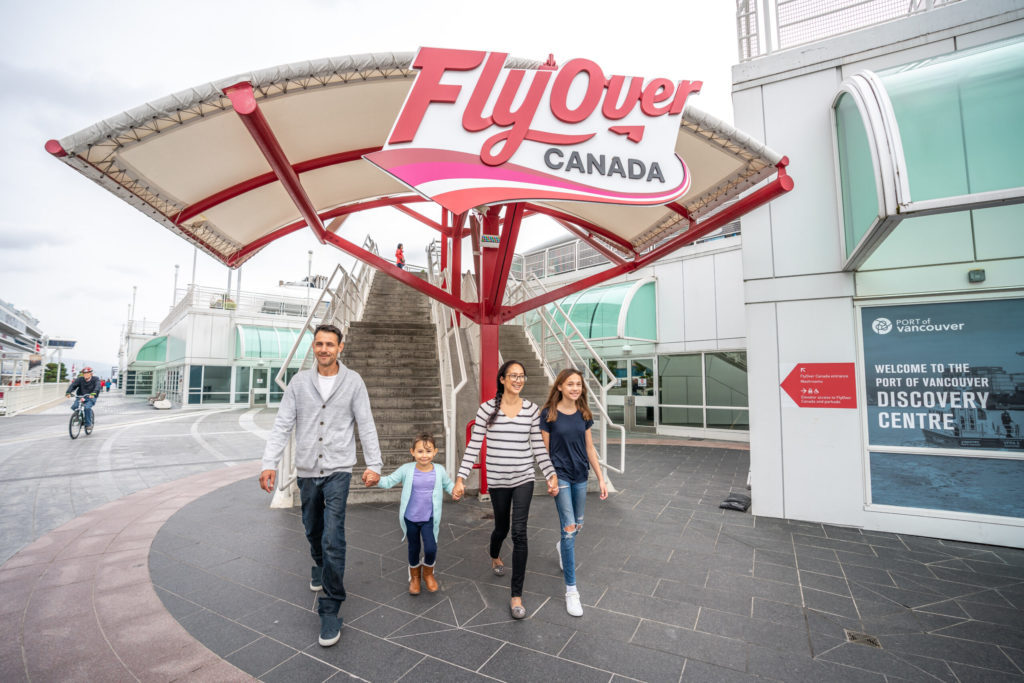
The nature of the ride already forms a great basis for a standalone attraction: “It’s a show ride. It’s somewhere in-between a theatre and cinema. It’s not called a flying theatre by coincidence”, says Stefan. The show and theatre aspect of the ride are an important factor, but obviously, there is more to it.
A standalone attraction usually falls into the tourist attractions category. Most operators, such as FlyOver Canada or This Is Holland, build an experience that revolves around the country or region where the ride is located. Such an attraction does not just attract tourists, but it is also perfect for locals, since the movie shows their region from a whole different perspective than they usually see.
“It is about the value you expect as a guest when you go to a standalone attraction versus a theme park. Because in a theme park, you have hundreds of attractions you can choose from. A flying theatre is just one part of your daily experience. But for a standalone, you buy one ticket and you want some value from this experience,” explains Stefan. “At the moment people still think of value in time. You cannot sell a ticket for a 5 minute experience. So they were thinking about how to make it an experience that is worth the price.”
The flying theatre will obviously be the main show of the experience. Usually a ride on a flying theatre takes around 3 to 4 minutes. For a standalone flying theatre, the ride time must be extended. “Normally at least 6 to 8 minutes, sometimes even longer. I think the one in Amsterdam (This Is Holland) is longer than 10 minutes,” explains Stefan.
The whole experience can be extended by pre-shows, which usually tells some history about the things you are about to see during the flight movie. “Like in Holland, you have two pre-shows. At least one long pre-show and then what we call the safety video, which some operators make like another pre-show”, tells Stefan, “So in the end you have like 30 minutes of experience you go through.”
Even with the extended experience, it remains hard to sell the experience to the public. A flying theatre is inside a ‘black box’ and it is hard to explain in contrast to for example a roller coaster. In the past, we have seen that theme parks usually market their roller coasters as the highlight of the park, since it is easy to promote a new roller coaster by showing images or video footage. New visitors can relate to previous experiences on other roller coasters. You can see that a new roller coaster can attract a lot of visitors, but over the years, the visitor numbers will drop when the roller coaster gets older.
The standalone attractions seem to be doing the opposite and Stefan knows why: “With Media based attractions, it’s the other way around. It will start slow, because word of mouth has to build”, says Stefan, “It’s a challenge to make the attraction known, because it is very hard to talk about. You can’t see anything, it’s in a black box. That’s the problem with indoor rides, you can’t take a picture of it. At least it’s a challenge. And if you take pictures, you can hardly see what you experience”, he adds.
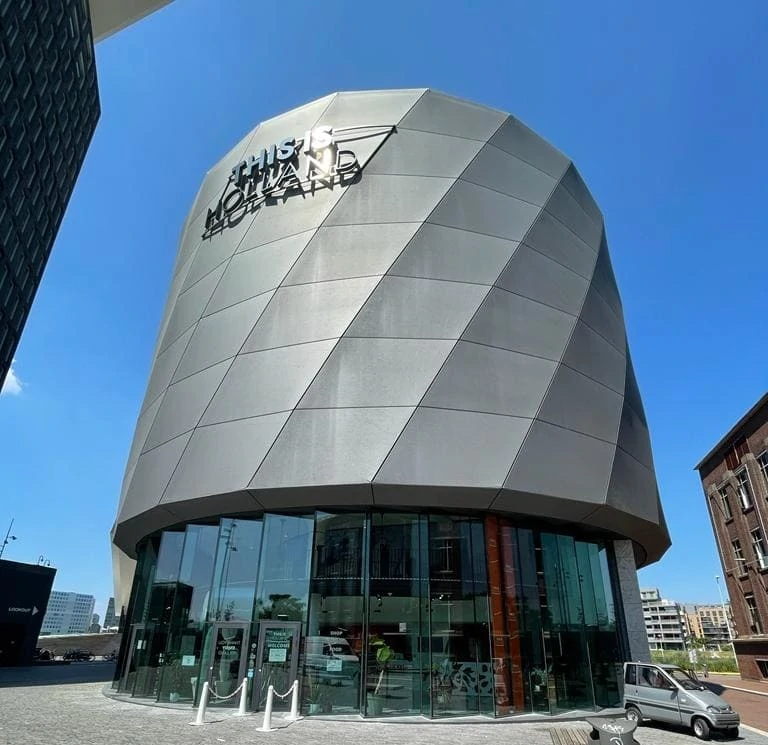
According to Stefan, the standalone flying theatres have seen a rise in visitor numbers over the years: “It is just the challenge in the beginning to communicate in words somehow, only to get the visitors in. And when they get in, they will love it. They will talk about it and then word of mouth will build up and do the rest.”
FlyOver Canada was a huge success and led to a second installation: FlyOver America in the Mall of America (Bloomington, Minnesota), that opened on April 19th 2016. Soaring Attractions was sold to Persuit in December 2016. Persuit expanded the FlyOver chain with FlyOver Iceland (Reykjavik) in September 2019, FlyOver Las Vegas in September 2021 and are still developing FlyOver Toronto (2022). The company holds a strong partnership with Brogent.
Brogent even operates two flying theatres by themselves. The first one was built in their own factory in Kaohsiung. Originally it was meant for Brogent to be able to make new developments and to give potential new clients the ride experience. “The biggest drive why we built this flying theatre in Taiwan was because we made such a great product, but the product could only be experienced abroad. Obviously, we had the ride in E-DA, but that ride was the very first one and very different to what we later delivered to Vancouver and all over the world.” The ride was initially not open to the public.
When Brogent decided to start operating their own flying theatre, they started with a completely new one in 2019: i-Ride Taipei. It wasn’t much later when they made the decision to open their factory based ride too: “Since we started the one in Taipei, we thought why not open the one in Kaohsiung to the public as well?”. The Kaohsiung i-Ride also opened in the same year. Operating your own rides gives you a certain advantage: “If you start to operate it yourself, you have the same problems your clients have and you can understand much better and work on it to improve it further” explains Stefan.

Media and motion programming
Everyone who has experienced a flying theatre knows that they rely heavily on audiovisual media for the ride experience. But how does an operator of a flying theatre get the flight film? Who makes these?
“They often come from a third party,” explains Stefan, “We try to have a lot of communication with the production companies before they start to produce the movie to bring it up to the highest possible level, because we know this will impact the experience quality immensely.”
In most cases, the client already knows what kind of film they want and will contact the film developer themselves. In the case of Voletarium in Europa-Park (owned by Mack Rides), it was clear that MackMedia would produce the flight film. Merlin Entertainment, owners of Legoland, has Pure Imagination as their partners in media development for their 3D theatres. They also created a film for their Flying Theatres.
Brogent always tries to cooperate with the media developer. “We normally strongly recommend people who will produce their first Flying Theatre movie to come to Taiwan, if that is possible. We will show them examples and give them a checklist with what the best and worst things to do are when producing a flying theatre movie. It is a little bit like a workshop” tells Stefan.
Producing a film for a flying theatre is more than just creating aerial shots from various places. If you want to do it well, you must create a flight path. While the production company is still shooting its movie, Brogent can already start programming: “If we know how the gondola will fly, we can make a motion profile and even show it to the project participants. They can already experience that very early in the project. Maybe not based on the final movie, but on some animation,” explains Stefan.
Brogent also tries to keep in touch with the production company and provides them with test options in their factory theatre. “Things are looking very different when you view them on a laptop screen or if you put them on a 20 meter screen. So we try to find some way to let them check it on a bigger screen as early as possible in the process so they can make adjustments”, says Stefan.
“We try to motivate people to share the plans with us as early as possible, to avoid problems later. Because, the later you are in the production process, the more expensive it gets to make changes. When something is ‘wrong’, the only thing we can do is motion programming tricks to still make it nice, but there are limits to that, so we try to do that early in the process already to start this communication.”
Brogent has a lot of good experience with the companies producing the ride media, says Stefan. “We also have to be really grateful to these great partners that worked with us on the different projects and have really done most of the time very good movies that make the ride system shine” says Stefan.
But the motion programming is just as important as the film. “Our programmers, they are like artists. Not only every movie director has his own style, also every motion programmer has his own style, because it is really like a piece of art”, says Stefan. Sometimes opinions on motion programming vary. “If you want to convince the motion programmer to make some adjustments, maybe he doesn’t want to because he thinks he already did the very best,” tells Stefan, “You can literally ride the ride a hundred times and do some adjustments to the motions and when the special effects would hit. When the mist should come out. Little bit more movement, a little bit less.”
The time it takes to program the ride differs, based on the people involved in the project. The more of a perfectionist they are, the longer it takes. But normally it would take roughly a month to program the first version of a ride. After that, programmers can fine tune the ride all the time.
Recently, we have already seen operators of flying theatres change their films. With more flying theatres opening, more content becomes available as well. Stefan even sees a trend in the production business: “There are even now companies coming out that just make movies for flying theatres. We now have a standard for this kind of ride, so they produce for that and hope they can penetrate the market.” That is something that the whole flying theatre industry can benefit from as potential clients can soon pick a movie from a library and change movies from time to time to relaunch the flying theatre as a new experience.
The Persuit company has exchanged movies between their attractions. For example: the FlyOver Canada installation now also shows FlyOver Iceland. For them, it does not come with any additional costs, since they produced the movies on their own. Other operators would have to pay for the license of a movie if they use third party content.
An operator can usually install more than one movie and alternate between them. The only limit the theatres have is the size of the media server. “It depends on the size of the server they bought in the beginning, but normally two or three movies is not a problem. If it gets over that, we need to see if we can upgrade it,” explains Stefan.
However, all projects of Brogent are custom and contain variations in techniques. This means that the motion programming of a theatre cannot be copied one-on-one to another theatre. “We still need to do some adjustments. Maybe 80% is the same and we do about 20% adjustments. The basic movement can be used and we just need to do some fine tuning,” tells Stefan. After a new movie is installed and the motion programming is adjusted, playing a different film is just the switch of a button.
In recent years, Brogent also started working on their own media content. “We have two theatres running in Taiwan and for that we did our own movies: ‘Flying Over Taiwan’. We shot those ourselves and we got some experience in movie production” tells Stefan. Perhaps in the future, Brogent will produce more flying theatre films for customers.
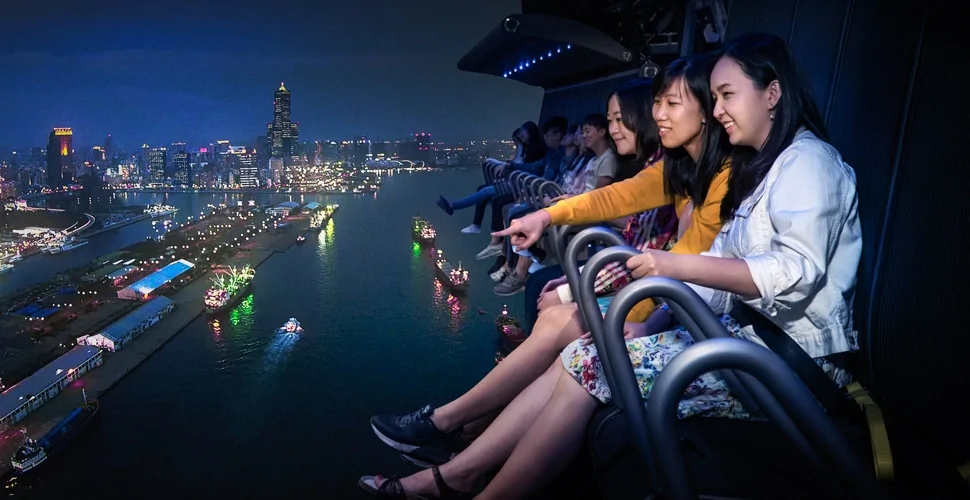
Further development to the m-Ride
In a park or standalone, the i-Ride has been a huge success over the last decade. However, Brogent is always looking for improvements. “After selling the i-Ride for 10 years, we sat down together and thought: what do the operators talk about? What problems have we faced when selling the ride? Basically, it came up to two points. For the experience, they always say: you have no reveal”, tells Stefan.
Riders at Disney’s Soarin’ have a realistic ‘takeoff’ that raises them to the right altitude and to the screen. It is something that immediately amazes riders. Brogent’s i-Ride does not have such a takeoff. Instead, a curtain is raised or moved as the gondolas move forward. According to Stefan, it hardly feels like a reveal. “We thought: how can we do such a reveal and still stick to the multi-level concept? We wanted something like a madhouse, where you sit down and don’t know what will happen if you ride it for the first time.”
To create a flying theatre with a reveal, Brogent designed a completely new version: the m-Ride. This second version of the flying theatre still has balconies on different levels, but the gondolas are now placed between the balcony and the screen. Riders will take a seat with the screen behind them and when the ride starts, the gondolas will turn 180 degrees to face the screen.
“You sit down with your back to the screen. You don’t even know the screen is there, you are completely unaware of what will follow. Suddenly you turn around and the screen is already playing something and you’re just overwhelmed. That was our take on how you can add excitement to the experience”, explains Stefan.
The second problem that the m-Ride solved was the floor height. Brogent received a lot of requests from clients who wanted a flying theatre, but were limited to an existing building. Space in an existing building is almost always limited. Brogent solved this problem:
“The biggest change is that we removed the roll movement, the left-right of the gondola. Because, the left right of the gondola will require a large safety envelope, you have additional movement in the height because you bank left and right. The m-Ride does not have roll movement.” The company compromised on this movement, but also looked at its competition. “Soarin’ has no roll-movement either, so we thought we could give up on that to make the flying theatre more affordable and more compact to find new markets,” tells Stefan.
The m-Ride also has a less sophisticated special effects system: the effects are not distributed to each individual rider anymore, but to two or three riders at the same time. With the attention focused on the movie, most riders will probably not even notice this change.
Good examples of the m-Rides are the flying theatres of the Legoland parks: LEGO Movie – Masters of Flight in Florida (U.S.A.), Emmet’s Flying Adventure – Masters of Flight in Billund (Denmark), Emmet’s Flying Adventure Ride in California (U.S.A.) and Flight of the Sky Lion at Windsor (England).
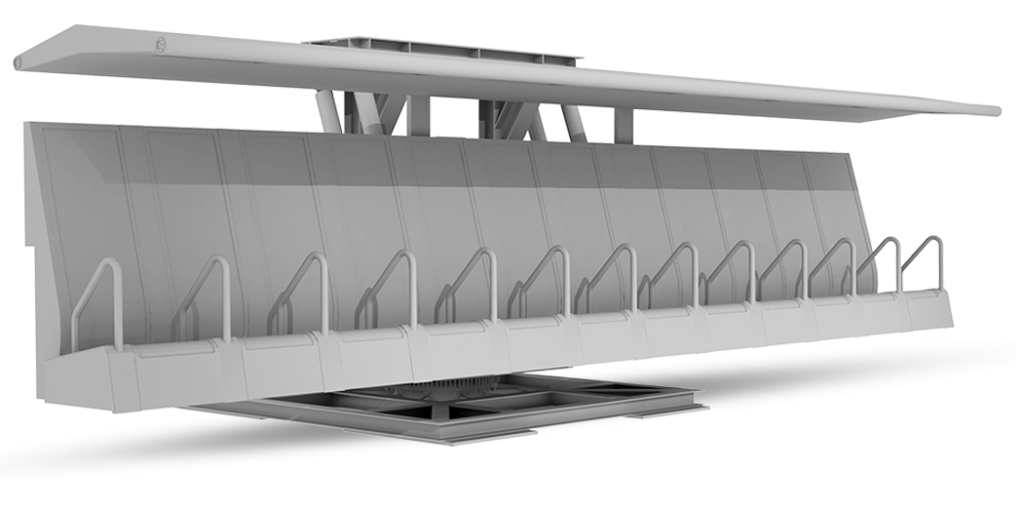
The success of the flying theatre
Brogent Technologies is still working on expanding its catalogue, but the flying theatre will probably still be the most popular product in the upcoming years. “There are so many different markets we can sell to. We are talking to science museums, zoos, aquariums and shopping malls. Basically we can sell it to everyone. It’s not only theme parks. In China, we are now looking at national parks. They have beautiful nature parks, comparable to the national parks in the USA and if you show that from a flying perspective, it is also very interesting. There are really endless possibilities”, says Stafan.
Disney proved that a flying theatre in a theme park can be a success, but together with various operators, Brogent showed it can also be a success as a standalone attraction: “Why it can be a standalone has to do with the wide range of audience and the emotion and fascination that people have about flying,” tells Stefan. For thousands of years, mankind has had the wish to fly. The film of a flying theatre, combined with the movement of the gondolas gives you a feeling of freedom that can hardly be experienced during a real flight. “A flying theatre is just something special,” adds Stefan.
It is this feeling that gives a flying theatre a high repeatability. Stefan has experienced that himself: “I rode it hundreds, maybe even thousands of times. I just never get bored of it. I don’t know why that is the case, but that’s why I really think the Flying Theatre is a really good attraction.”
After this interview, we have good confidence that we will see a lot more Brogent rides in the future. Of course we will expect many new flying theatres, but hope to see more show and dark rides of Brogent being built. We would like to thank Stefan again for his time and insightful stories about the Flying Theatre.
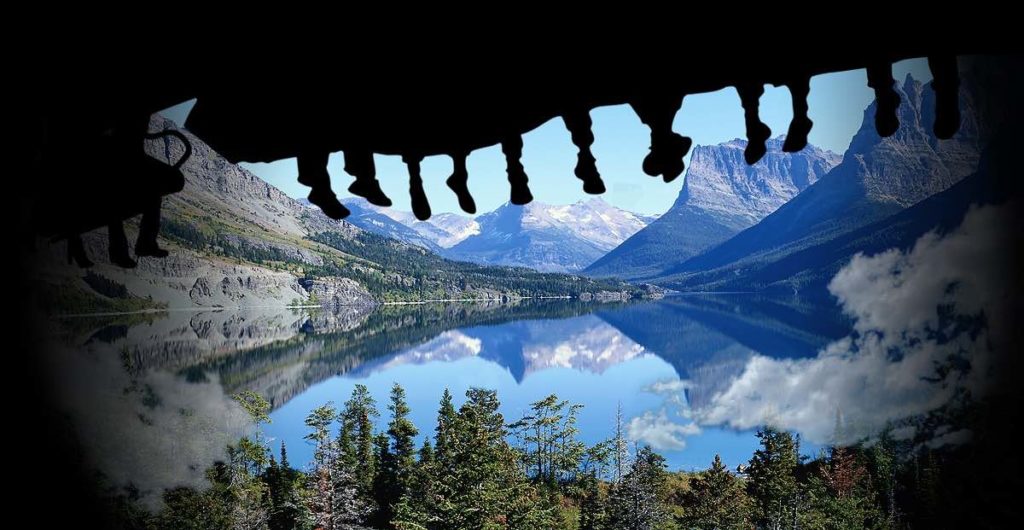
© 2021 Dark Ride Database
Interview by Erik and Johan
Article by Erik



